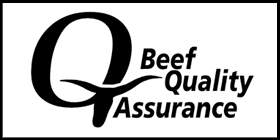– Steve Boyles, OSU Beef Extension Specialist
Beef Quality Assurance (BQA) is a nationally coordinated, state implemented program to ensure that beef and dairy cattle are maintained in a manner which will result in a safe and wholesome beef product for the consumer. Times and locations for the series of upcoming BQA certification programs being held for producers throughout Ohio are posted under the EVENTS/PROGRAMS link at our OSU Beef Team website: http://beef.osu.edu.
a safe and wholesome beef product for the consumer. Times and locations for the series of upcoming BQA certification programs being held for producers throughout Ohio are posted under the EVENTS/PROGRAMS link at our OSU Beef Team website: http://beef.osu.edu.
Producers interested in getting BQA certified can also do it on-line at the National BQA website https://www.bqa.org/
The following are the BQA Guidelines being relayed at the Ohio BQA events.
Care and Husbandry Practices
- Follow a “Quality Assurance Herd Health Plan” that conforms to good veterinary and husbandry practices
- Handle/transport all cattle in such a fashion to minimize stress, injury and bruising
- Regularly inspect facilities (fences, corrals, load-outs, stations, freestall areas, alleys, etc.) to help ensure proper care and ease of handling
- Keep feed and water handling equipment clean
- Provide appropriate nutritional and feedstuff management
- Maintain an environment appropriate to the production setting
- Evaluate and enforce biosecurity
- Keep records for a minimum of 2 years or longer as required by laws/regulations (ie. 3 years for Restricted Use Pesticides)
Feedstuffs
- Maintain records of any pesticide use on pasture or crops that could potentially lead to violative residue in cattle
- A quality control program is in place for incoming feedstuffs that is designed to help eliminate contamination from mold, mycotoxins or chemicals incoming feed ingredients. Supplier assurance of feed ingredient quality is recommended.
- Analyze suspect feedstuffs prior to use.
- Do not feed ruminant-derived protein sources per FDA regulations
- Support feeding of by-product/co-product ingredients with sound science
Feed Additives and Medications
- Use only FDA-approved medicated feed additives in rations
- Use medicated feed additives in accordance with FDA current Good Manufacturing Practices (cGMPs)
- Follow Judicious Antibiotic Use Guidelines
- Extra-label use of feed additives is illegal and strictly prohibited
- Strictly adhere to medication withdrawal times to avoid a violative residue
- Where applicable, keep complete records when formulating or feeding medicated feed rations
- Records are to be kept a minimum of two years or longer as required by laws/regulations
- Assure that all additives are withdrawn at the proper time to avoid a violative residue
Processing/Treatment Records
- Follow all FDA/USDA/EPA guidelines for each product
- Follow all label direction for each product
- Extra-label drug use shall be kept to a minimum, and used only when prescribed by a veterinarian working under a Veterinary/Client/Patient Relationship (VCPR)
- Strict adherence to extended withdrawal periods (as determined by veterinarian within the context of a VCPR) shall be employe
- Individual animal or group identification
- When cattle are treated/processed individually, treatment records will be maintained with the following records:
– Individual animal identification
– Date treated
– Product administered and manufacturer’s lot/serial number
– Dosage
– Route and location of administration
– Earliest date animal will have cleared with withdrawal period
– Name of individual administering the treatment - When cattle are treated/processed as a group, all cattle with the group shall be identified as such, and the following information recorded:
– Group or lot identification
– Date treated
– Product administered and manufacturer’s lot/serial number
– Dosage
– Route and location of administration
– Earliest date animal will have cleared the withdrawal period
– Name of individual administering the treatment - All cattle (fed and beef or dairy market cows/bulls) shipped to harvest will be checked by appropriate personnel to ensure that animals that have been treated have met label or prescription withdrawal times for all animal health products administered
- All processing treatment records should be transferred with the cattle to next production level. Prospective buyers must be informed of any cattle that have not met withdrawal times
Injectable Animal Health Products
- Always follow label requirements
- Products labeled for subcutaneous (SQ), Intravenous (IV), Intranasal (IN) or oral administration are recommended
- Products with low dosage rates are recommended and proper spacing of injections should be followed
- All products labeled for intramuscular use shall be delivered in the neck region only (no exceptions, regardless of age)
- All products can cause tissue damage when injected IM. Therefore all IM use should be avoided if possible
- No more than 10 CC of product is administered per IM injection site



Leave A Comment